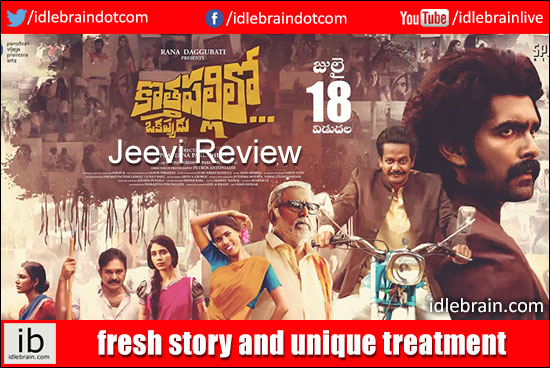|
|
Story
The story is set in the early 90s in a village called Kothapalli. Rama Krishna (Manoj Chandra), who works for a moneylender named Appanna (Ravindra Vijay), has been in love with Savitri (Monika T), the granddaughter of the landlord Reddy (Benarjee), since childhood. Alongside his job, he runs a recording dance troupe and is on the lookout for a female dancer. To persuade Savitri to join his troupe, he enlists Aadhi Laxmi (Usha Bonela) as a mediator. The rest of the story revolves around the unexpected events that throw Rama Krishna’s life into a major crisis.
Artists Performance
Manoj Chandra makes a strong impression with his performance. Despite being a newcomer, he captures the character's quirkiness and spontaneity with remarkable ease. If he continues making smart choices, he’s certainly headed for a promising future. Ravindra Vijay delivers a convincing performance as a moneylender, while Usha Bonela brings in the entertainment factor. Monika T is adequate in her role. Banerjee stands out with a realistic and impactful portrayal of a landlord. Praveena Paruchuri takes on a unique role and does full justice to it. Jai Ram is effective in his dual responsibilities as a priest and constable. Babu Mohan makes a brief but satisfactory appearance. Shining Phani and Bongu Sathi are effortlessly natural as the hero’s sidekicks.
Story - screenplay - direction: The story, penned by Guru Kiran Battula, touches upon multiple social themes such as caste-based oppression, the exploitation of villagers by moneylenders, and the commercialization of faith - like building temples around ordinary individuals and turning them into deities. The debutant director has opted for a refreshingly unique narrative and infused the first half with a vibrant dose of rural humor and entertainment. The characterizations are distinct and reminiscent of the storytelling style seen in films by Vamsi and Krishna Vamsi.
The treatment of the film stands out, especially in how the comedic and emotional beats are handled between the hero and the heroine’s sidekick - often more engaging than the lead pair themselves. Several moments are notably quirky - for example, the hero inquiring about the heroine while her friend is defecating in an open field, a scenario once commonplace in rural areas. The triangular dynamic between the hero, heroine, and her friend brings a delightful and humorous layer to the narrative. Since the hero plays a recording dance organizer, the film is filled with nostalgic references to the 1980s and 90s — particularly to Chiranjeevi’s iconic films like Gang Leader and Challenge.
One standout scene involves a physical altercation between two women, captured with surprising authenticity and humor, especially considering the director's NRI background. The second half takes a more serious and philosophical turn, centering on the idea of faith and temple construction. It poses a powerful moral question: is it right to build a temple for a man who, during his lifetime, ruined the lives of innocent people? The film eventually offers a satisfying and thought-provoking resolution to this dilemma.
Adding to the charm is a touch of magical realism, most notably through a self-driving motorcycle that even performs stunts. All in all, this marks a strong debut for Praveena Paruchuri, who manages to balance engaging entertainment with deeper reflections on belief and societal contradictions.
Other departments: The songs composed by Mani Sharma are quite effective, with “Yelo Yennello” standing out as a highly entertaining number - thanks to both its catchy tune and entertaining visuals. The “Biscuit Biscuit” track, styled as a recording song, is presented with a fresh visual approach, while “Ranga Nayaki” impresses with its unique picturisation and notable lyrics.
The cinematography by Petros Antoniadis, a foreign DOP, is commendable. His work beautifully captures the 1990s rural setting, enhanced by the use of anamorphic lenses that lend the film a distinctive visual tone, complementing its theme. The dialogues are well-written, and the editing by Kiran is smooth overall.
The film was shot using a sync sound setup, which largely works well, although a few sync issues are noticeable in certain scenes during the second half. The production design by Vishal Gyanchandani and Jitendra Mourya feels authentic and true to the film’s setting. Remarkably, the entire film was shot in just 33 days on a limited budget, yet the visuals hold up impressively for a story rooted in a rural backdrop.
Analysis: Praveena Paruchuri, who earlier produced the award-winning ℅ Kancharapalem, makes her directorial debut with Kothapallilo Okappudu. The writing feels organic, enriched with sensible village humor and well-chosen casting. While the second half shifts into a more serious tone, the film remains a worthwhile watch for its fresh story and unique treatment.
|

